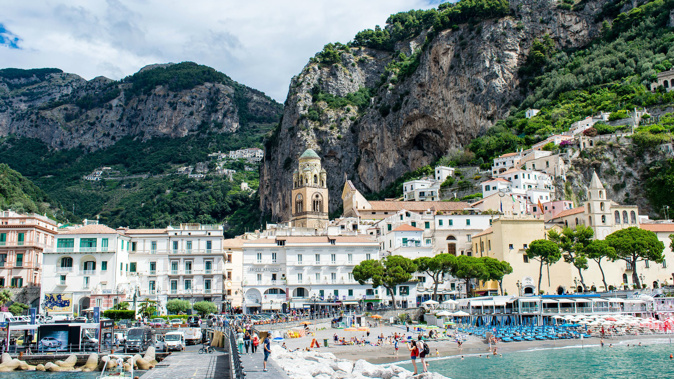
Sun-kissed Sorrento is the perfect base for travel forays along the Amalfi Coast, one of Italy’s most well-endowed gateway destinations. Just three hours from Rome, and with Pompeii, the Amalfi and Capri within easy reach, sun-kissed Sorrento lustily struts the volcanic cliffs of the Bay of Naples. Just as its mythical sea maidens perilously lured passing Greek sailors to its shores, Sorrento still exudes a siren-like pull on today’s travellers. (Homer’s Ulysses escaped the seductive tug of the sirens by ordering his oarsmen to plug their ears with wax, and by strapping himself to the ship’s mast as he sailed past Sorrento.)
When you first arrive, it’s the breath-taking cliff-top views and wide horizons, stretching out across the ocean and over the bay to Naples and towering Mt. Vesuvius that will leave you transfixed. The surrounding, terraced countryside is wreathed in citrus groves and sprawling blazes of bougainvillea. The region left the great romance writers, Lord Byron, Keats and Goethe all gushing, which catalysed the massive tourism industry that duly unfolded. Citrus fruit is the other key staple to the regional economy, and if your visit coincides with late summer, you can literally pluck the sweetest, ripest lemons and oranges straight from the trees, that lace the city’s streets.
Sorrento’s most famous export is limoncello, an alcoholic drink made from lemon rinds, alcohol, water and sugar. Commercially sold in ornate bottles of various shapes and sizes, and ever-present in the tourist areas, they are an indelible souvenir to tuck away in your suitcase. This thirst-quenching, high-octane liqueur is a particularly good poured over ice-cream.
You can check out the nerve-centre of this iconic Sorrentine drink, by paying a visit to the Limoncello Factory, on Via Correale. The strikingly-named Corso Italia is the city’s main street which runs the length of Sorrento and is lined with a profusion of designer boutiques and swanky restaurants. The corso climaxes in the colourful heart of town, Piazza Tasso. This photogenic, convivial town square throngs with tourists in the summer months, and features a range of attractive al-fresco restaurants. My favourite was Syrenuse Bar Ristorante, a classic column-lined , open-air venue boasting a wealth of delicious Italian dishes, without burning a hole in your pocket. I plumped for the scrumptious local specialty, gnocchi alla sorrentina. (Gnocchi baked in tomato sauce with mozzarella.)
A maze of narrow streets and pedestrianised lanes peel off from the piazza, and they’re packed to the gunwales with trinket shops, market stalls and cafes. This bustling tourist honey pot is well worth a wander...and you will soon lose count on the number of limoncello shops! Sorrento’s most revered building is the gleaming Duomo, a church with an exuberantly decorated interior. Of particular note are the marble bishop’s throne and the exquisitely carved wooden choir stalls. The city’s 16,000 inhabitants are deeply religious, and their patron saint, Sant’Antonino is credited with having saved Sorrento during World War II, in contrast to the neighbouring cities of Naples and Salerno that were heavily bombed.
All of the ferries and hydrofoils, connecting Sorrento with Naples, Capri and Amalfi leave from Marina Piccola, and after soaking up the sights on a day-trip, under the hot Italian sun, the 200 stepped cliff-side walk connecting the port back up to the town centre, may pose as a formidably lung-bursting, calf-burning assignment. There is an elevator.
You can take your chances in a rental car on the maze of serpentine roads that lace the region’s rocky coast – but a far more leisurely option is to take advantage of the outstanding public transport, whether it be by bus or hydrofoil. Be sure to take the bus at least one way, and you will get a first-hand appreciation of the region’s mountainous terrain, awash in rustic villages, terraced citrus orchards and olive groves – and head-spinning coastal views that are to die for.
As your bus driver admirably negotiates the impossibly narrow lanes and continuous hair-pin bends, your nose will be pressed against the window lapping up the vistas of white-washed villas clinging tenaciously to the sheer slopes that drop vertically to the vividly blue waters below. The bus service connects Sorrento to the two main tourist meccas, the villages of Positano and Amalfi. If you have the time, stop off at both – although, my favourite is Amalfi. Home to 5000 residents, this photogenic honey-pot is swamped by millions of day-trippers every year.
Amalfi village was once the capital of a powerful maritime republic, but much of the old city and its populace literally slid into the sea, following a monster earthquake in 1743. However some medieval gems survived the tragedy, notably the Piazza del Duomo, which is dominated by the sweeping flight of stairs that lead up to the dazzling Cattedrale di Sant’Andrea. The cathedral dates back to the 10th century, although its striking marble striped facade has been remodelled twice. The extravagant baroque interior with gilded fittings and trimmings is pure eye-candy.
If you have a hankering for some serious exercise in the great outdoors, set aside a day for the region’s tour de force on foot is the Walk of the Gods. The 12 km trek links Positano with the southern village of Praiano, carving its way through spectacular countryside and limestone cliffs. Much of the walk requires navigating steep, rocky paths. There are a variety of walking options, depending on how much of the coastal path you wish to conquer.
If you’re short on time, here’s a short-cut, to savour the best slice of this blessed coastal path. Buy a bus ticket in Positano from a tabacchi and get them to point you in the direction of the bus stop to Nocelle. From Nocelle, which is a mountain-top village, totter down the Walk of the Gods to Positano, as you suck in the heavenly views. It is certainly feels easier walking down the mountainside than up, although be warned – the bodily impact can be delayed. You may well assume the posture of a waddling penguin for several days afterwards.
Mike Yardley is Newstalk ZB’s Travel Correspondent on Saturday Mornings with Jack Tame.
Take your Radio, Podcasts and Music with you









